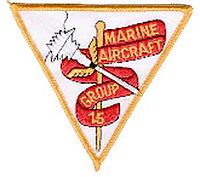- Marine Aircraft Group 15
-
Marine Aircraft Group 15 
MAG-15 insigniaActive 1 March 1942 – December 1989 Country United States Allegiance United States of America Branch United States Marine Corps Engagements World War II Marine Aircraft Group 15 (MAG-15) was a United States Marine Corps aviation group established during World War II. MAG-15, a transport and photo-reconnaissance training group, was commissioned on 1 March 1942, headquartered at Camp Kearny, San Diego. In addition to radio and photographic training, the Group also conducted a navigation school. Additional roles included West Coast aircraft acceptance and transport service for the Marine Corps.
Contents
History
World War II
Marine Aircraft Group 15 was commissioned on 1 March 1942 at Camp Kearny, San Diego, California.[1] For the next two years the group remained there as the transportation, observation and photo reconnaissance training group. They trained pilots and crews to serve in the South Pacific Combat Air Transport Command (SCAT).[2] From its commission in 1942 until 1944, MAG-15 trained and dispatched the following unit for overseas deployment: VMD-154 and VMD-254; VMO-151 and VMO-155; and VMJ-152, VMJ-153, VMJ-353, VMJ-952, and VMJ-953.[2]
MAG-15 shipped out from Camp Kearny to the South Pacific on 2 March 1944. They arrived in Apamama on 1 April and operated from there as part of the Transport Air Group until October 1944. In October they were ordered to establish the Air Transport Group (ATG) in order to provide transportation services to units in the Marshall and Gilbert Islands.[2] ATG was redesignated the Troop Carrier Group (TCG) in November 1944. MAG-15 then became part of Task Unit 96.1 which was disbanded shortly thereafter on 25 March 1945 as its responsibilities were assumed by the NATS.[1][2]
Headquarters Squadron 15 was sent to Marine Corps Air Station Ewa, Hawaii in April 1945 and was quickly joined by VMR-953 and VMR-352.[2] They stayed there through the end of the war becoming part of the TAG again and controlling the transportation units for the Marines throughout the Pacific.[1]
In January 1947 the group became dual roled when they also had fighter squadrons attach and in May 1947 they became all fighter squadrons. In March 1949 they returned to the United States and were based at Marine Corps Air Station Edenton, North Carolina.[1]
Vietnam War
MAG-15 moved to Marine Corps Air Station Iwakuni in July 1966 and included VMCJ-1, VMA(AW)-533, VMFA-334 and VMFA-232.
Stand down
In December 1989, MAG-15 stood down after 46 years of service.[3]
Notable commanders
- Peter Pace, former Chairman of the Joint Chiefs of Staff served as executive officer, 1972–1973.
See also
Notes
References
Books
- Rottman, Gordon L. (2002). U.S. Marine Corps World War II Order of Battle – Ground and Air Units in the Pacific War, 1939 – 1945.’’. Greenwood Press. ISBN 0-313-31906-5.
- Sherrod, Robert (1952). History of Marine Corps Aviation in World War II. Washington, D.C.: Combat Forces Press.
- Shettle Jr., M. L. (2001). United States Marine Corps Air Stations of World War II. Bowersville, Georgia: Schaertel Publishing Co.. ISBN 0-964-33882-3.
Web
- Historic California Posts: Marine Corps Air Station, Miramar, at militarymuseum.org. (URL accessed 26 May 2006)
- Vietnam War Bibliography: U.S. Marine Corps Publications and Documents, Clemson University. (URL accessed 27 May 2006).
Categories:- United States Marine Corps aircraft groups
Wikimedia Foundation. 2010.


